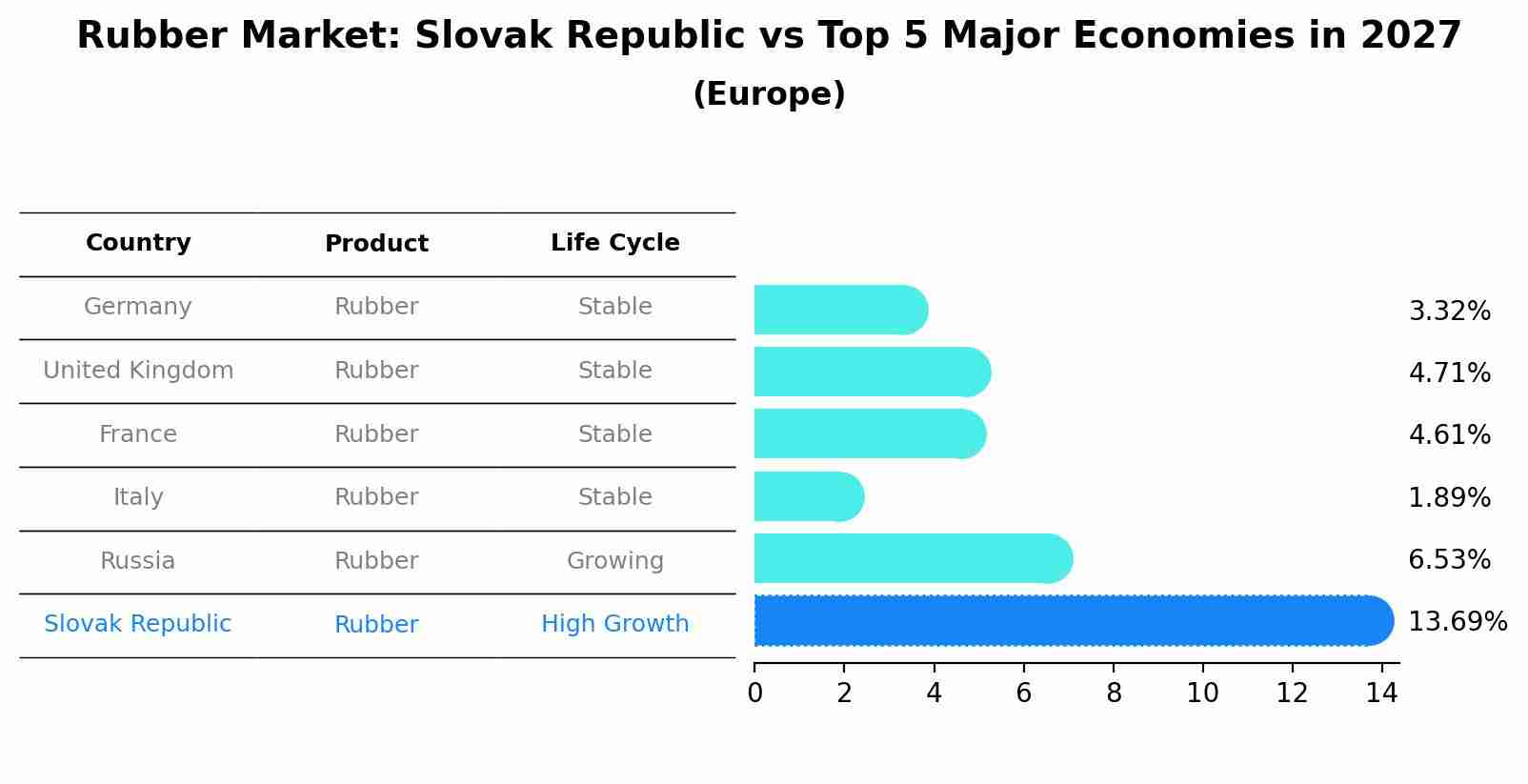Slovakia Rubber Market | COVID-19 IMPACT, Share, Size, Companies, Analysis, Revenue, Outlook, Forecast, Trends, Industry, Growth & Value
| Product Code: ETC172419 | Publication Date: Jan 2022 | Updated Date: Jun 2025 | Product Type: Market Research Report | |
| Publisher: 6Wresearch | Author: Sachin Kumar Rai | No. of Pages: 70 | No. of Figures: 35 | No. of Tables: 5 |
Slovak Republic Rubber Market Size Growth Rate
The Slovak Republic Rubber Market is poised for steady growth rate improvements from 2025 to 2029. Commencing at 6.84% in 2025, growth builds up to 16.81% by 2029.

Rubber Market: Slovak Republic vs Top 5 Major Economies in 2027 (Europe)
Slovak Republic's Rubber market is anticipated to experience a high growth rate of 13.69% by 2027, reflecting trends observed in the largest economy Germany, followed by United Kingdom, France, Italy and Russia.

Slovakia Rubber Market Overview
The Slovakia Rubber Market is experiencing steady growth driven by increasing demand from industries such as automotive, construction, and manufacturing. The market is primarily driven by the production and consumption of rubber products including tires, hoses, belts, and seals. Slovakia`s strategic location in Central Europe allows for easy access to key markets, contributing to the country`s position as a significant player in the European rubber industry. The market is characterized by a mix of domestic and international players, with a focus on innovation, quality, and sustainability. Government initiatives to promote the rubber industry, coupled with investments in research and development, are expected to further propel the growth of the Slovakia Rubber Market in the coming years.
Slovakia Rubber Market Trends
The Slovakia rubber market is witnessing several key trends. One prominent trend is the increasing demand for eco-friendly and sustainable rubber products, driven by growing environmental awareness among consumers. Manufacturers are focusing on developing bio-based and recycled rubber materials to meet this demand. Another trend is the rising adoption of advanced technologies in rubber production processes, including automation and digitalization, to enhance efficiency and reduce costs. Additionally, there is a growing emphasis on product innovation and customization to cater to diverse industry requirements. Moreover, the market is experiencing a shift towards strategic partnerships and collaborations among key players to expand their market presence and capabilities. Overall, these trends are shaping the Slovakia rubber market towards more sustainable practices and enhanced competitiveness.
Slovakia Rubber Market Challenges
In the Slovakia Rubber Market, one of the main challenges faced is intense competition from both domestic and international players. This competition often leads to price wars and margin pressures for companies operating in the market. Another challenge is the fluctuating prices of raw materials, such as natural rubber and synthetic rubber, which can impact the profitability of rubber manufacturers. Additionally, compliance with stringent regulations and standards related to environmental sustainability and product quality poses a challenge for companies in the market. Furthermore, the market also faces challenges in terms of technological advancements and innovation to meet the changing demands of customers for high-performance and eco-friendly rubber products. Overall, navigating these challenges requires companies in the Slovakia Rubber Market to adopt strategic planning, efficient operations, and continuous innovation.
Slovakia Rubber Market Investment Opportunities
The Slovakia Rubber Market presents several investment opportunities due to the country`s strong automotive industry and the growing demand for rubber products. Investing in rubber manufacturing companies in Slovakia could be lucrative as they supply materials to the automotive sector as well as other industries. Additionally, there is potential for growth in the production of specialized rubber products such as seals, gaskets, and industrial hoses to cater to various sectors. Investors could also consider opportunities in the recycling and sustainability aspects of the rubber market in Slovakia, as there is increasing focus on eco-friendly solutions. Overall, investing in the Slovakia Rubber Market could offer stable returns and growth potential in line with the country`s industrial development.
Slovakia Rubber Market Government Policy
The Slovakian government has implemented various policies related to the rubber market to support the industry`s growth and sustainability. These policies focus on promoting innovation and research in rubber production, ensuring compliance with environmental regulations to minimize pollution and waste, and supporting the development of a skilled workforce through training programs. Additionally, the government has put in place trade policies to facilitate smooth import and export of rubber products, as well as measures to protect domestic producers from unfair competition. Overall, the government`s policies aim to create a competitive and thriving rubber market in Slovakia while also addressing environmental concerns and ensuring the industry`s long-term viability.
Slovakia Rubber Market Future Outlook
The future outlook for the Slovakia Rubber Market appears positive, driven by the country`s expanding automotive industry and increasing demand for rubber products in various sectors such as construction, healthcare, and manufacturing. With a focus on technological advancements and innovation in rubber production processes, Slovakia is likely to witness growth in the market. Additionally, the government`s initiatives to attract foreign investments and promote the use of sustainable materials could further boost the rubber market in the country. However, challenges such as fluctuating raw material prices and global economic uncertainties may impact the market`s growth trajectory. Overall, the Slovakia Rubber Market is poised for steady growth in the coming years, supported by industry developments and increasing applications across different sectors.
Key Highlights of the Report:
- Slovakia Rubber Market Outlook
- Market Size of Slovakia Rubber Market, 2021
- Forecast of Slovakia Rubber Market, 2031
- Historical Data and Forecast of Slovakia Rubber Revenues & Volume for the Period 2018 - 2031
- Slovakia Rubber Market Trend Evolution
- Slovakia Rubber Market Drivers and Challenges
- Slovakia Rubber Price Trends
- Slovakia Rubber Porter's Five Forces
- Slovakia Rubber Industry Life Cycle
- Historical Data and Forecast of Slovakia Rubber Market Revenues & Volume By Type for the Period 2018 - 2031
- Historical Data and Forecast of Slovakia Rubber Market Revenues & Volume By Natural for the Period 2018 - 2031
- Historical Data and Forecast of Slovakia Rubber Market Revenues & Volume By Synthetic for the Period 2018 - 2031
- Historical Data and Forecast of Slovakia Rubber Market Revenues & Volume By Application for the Period 2018 - 2031
- Historical Data and Forecast of Slovakia Rubber Market Revenues & Volume By Tire for the Period 2018 - 2031
- Historical Data and Forecast of Slovakia Rubber Market Revenues & Volume By Non-Tire Automotive for the Period 2018 - 2031
- Historical Data and Forecast of Slovakia Rubber Market Revenues & Volume By Footwear for the Period 2018 - 2031
- Historical Data and Forecast of Slovakia Rubber Market Revenues & Volume By Industrial Goods for the Period 2018 - 2031
- Historical Data and Forecast of Slovakia Rubber Market Revenues & Volume By Others for the Period 2018 - 2031
- Slovakia Rubber Import Export Trade Statistics
- Market Opportunity Assessment By Type
- Market Opportunity Assessment By Application
- Slovakia Rubber Top Companies Market Share
- Slovakia Rubber Competitive Benchmarking By Technical and Operational Parameters
- Slovakia Rubber Company Profiles
- Slovakia Rubber Key Strategic Recommendations
Frequently Asked Questions About the Market Study (FAQs):
1 Executive Summary |
2 Introduction |
2.1 Key Highlights of the Report |
2.2 Report Description |
2.3 Market Scope & Segmentation |
2.4 Research Methodology |
2.5 Assumptions |
3 Slovakia Rubber Market Overview |
3.1 Slovakia Country Macro Economic Indicators |
3.2 Slovakia Rubber Market Revenues & Volume, 2021 & 2031F |
3.3 Slovakia Rubber Market - Industry Life Cycle |
3.4 Slovakia Rubber Market - Porter's Five Forces |
3.5 Slovakia Rubber Market Revenues & Volume Share, By Type, 2021 & 2031F |
3.6 Slovakia Rubber Market Revenues & Volume Share, By Application, 2021 & 2031F |
4 Slovakia Rubber Market Dynamics |
4.1 Impact Analysis |
4.2 Market Drivers |
4.3 Market Restraints |
5 Slovakia Rubber Market Trends |
6 Slovakia Rubber Market, By Types |
6.1 Slovakia Rubber Market, By Type |
6.1.1 Overview and Analysis |
6.1.2 Slovakia Rubber Market Revenues & Volume, By Type, 2021-2031F |
6.1.3 Slovakia Rubber Market Revenues & Volume, By Natural, 2021-2031F |
6.1.4 Slovakia Rubber Market Revenues & Volume, By Synthetic, 2021-2031F |
6.2 Slovakia Rubber Market, By Application |
6.2.1 Overview and Analysis |
6.2.2 Slovakia Rubber Market Revenues & Volume, By Tire, 2021-2031F |
6.2.3 Slovakia Rubber Market Revenues & Volume, By Non-Tire Automotive, 2021-2031F |
6.2.4 Slovakia Rubber Market Revenues & Volume, By Footwear, 2021-2031F |
6.2.5 Slovakia Rubber Market Revenues & Volume, By Industrial Goods, 2021-2031F |
6.2.6 Slovakia Rubber Market Revenues & Volume, By Others, 2021-2031F |
7 Slovakia Rubber Market Import-Export Trade Statistics |
7.1 Slovakia Rubber Market Export to Major Countries |
7.2 Slovakia Rubber Market Imports from Major Countries |
8 Slovakia Rubber Market Key Performance Indicators |
9 Slovakia Rubber Market - Opportunity Assessment |
9.1 Slovakia Rubber Market Opportunity Assessment, By Type, 2021 & 2031F |
9.2 Slovakia Rubber Market Opportunity Assessment, By Application, 2021 & 2031F |
10 Slovakia Rubber Market - Competitive Landscape |
10.1 Slovakia Rubber Market Revenue Share, By Companies, 2021 |
10.2 Slovakia Rubber Market Competitive Benchmarking, By Operating and Technical Parameters |
11 Company Profiles |
12 Recommendations |
13 Disclaimer |
- Single User License$ 1,995
- Department License$ 2,400
- Site License$ 3,120
- Global License$ 3,795
Search
Thought Leadership and Analyst Meet
Our Clients
Related Reports
- Germany Breakfast Food Market (2026-2032) | Industry, Share, Growth, Size, Companies, Value, Analysis, Revenue, Trends, Forecast & Outlook
- Australia Briquette Market (2025-2031) | Growth, Size, Revenue, Forecast, Analysis, Trends, Value, Share, Industry & Companies
- Vietnam System Integrator Market (2025-2031) | Size, Companies, Analysis, Industry, Value, Forecast, Growth, Trends, Revenue & Share
- ASEAN and Thailand Brain Health Supplements Market (2025-2031) | Strategy, Consumer Insights, Analysis, Investment Trends, Opportunities, Growth, Size, Share, Industry, Revenue, Segments, Value, Segmentation, Supply, Forecast, Restraints, Outlook, Competition, Drivers, Trends, Demand, Pricing Analysis, Competitive, Strategic Insights, Companies, Challenges
- ASEAN Bearings Market (2025-2031) | Strategy, Consumer Insights, Analysis, Investment Trends, Opportunities, Growth, Size, Share, Industry, Revenue, Segments, Value, Segmentation, Supply, Forecast, Restraints, Outlook, Competition, Drivers, Trends, Demand, Pricing Analysis, Competitive, Strategic Insights, Companies, Challenges
- Europe Flooring Market (2025-2031) | Outlook, Share, Industry, Trends, Forecast, Companies, Revenue, Size, Analysis, Growth & Value
- Saudi Arabia Manlift Market (2025-2031) | Outlook, Size, Growth, Trends, Companies, Industry, Revenue, Value, Share, Forecast & Analysis
- Uganda Excavator, Crane, and Wheel Loaders Market (2025-2031) | Strategy, Consumer Insights, Analysis, Investment Trends, Opportunities, Growth, Size, Share, Industry, Revenue, Segments, Value, Segmentation, Supply, Forecast, Restraints, Outlook, Competition, Drivers, Trends, Demand, Pricing Analysis, Competitive, Strategic Insights, Companies, Challenges
- Rwanda Excavator, Crane, and Wheel Loaders Market (2025-2031) | Strategy, Consumer Insights, Analysis, Investment Trends, Opportunities, Growth, Size, Share, Industry, Revenue, Segments, Value, Segmentation, Supply, Forecast, Restraints, Outlook, Competition, Drivers, Trends, Demand, Pricing Analysis, Competitive, Strategic Insights, Companies, Challenges
- Kenya Excavator, Crane, and Wheel Loaders Market (2025-2031) | Strategy, Consumer Insights, Analysis, Investment Trends, Opportunities, Growth, Size, Share, Industry, Revenue, Segments, Value, Segmentation, Supply, Forecast, Restraints, Outlook, Competition, Drivers, Trends, Demand, Pricing Analysis, Competitive, Strategic Insights, Companies, Challenges
Industry Events and Analyst Meet
Whitepaper
- Middle East & Africa Commercial Security Market Click here to view more.
- Middle East & Africa Fire Safety Systems & Equipment Market Click here to view more.
- GCC Drone Market Click here to view more.
- Middle East Lighting Fixture Market Click here to view more.
- GCC Physical & Perimeter Security Market Click here to view more.
6WResearch In News
- Doha a strategic location for EV manufacturing hub: IPA Qatar
- Demand for luxury TVs surging in the GCC, says Samsung
- Empowering Growth: The Thriving Journey of Bangladesh’s Cable Industry
- Demand for luxury TVs surging in the GCC, says Samsung
- Video call with a traditional healer? Once unthinkable, it’s now common in South Africa
- Intelligent Buildings To Smooth GCC’s Path To Net Zero


















